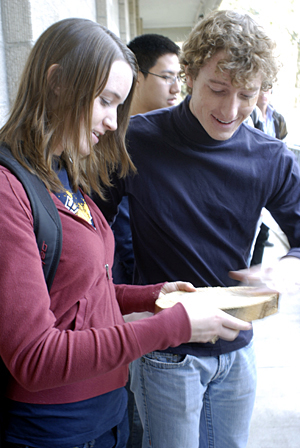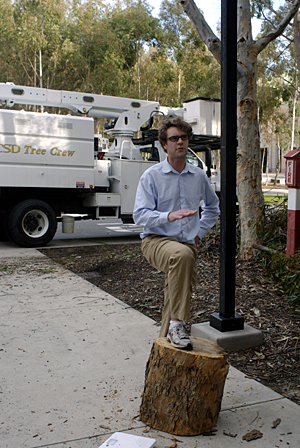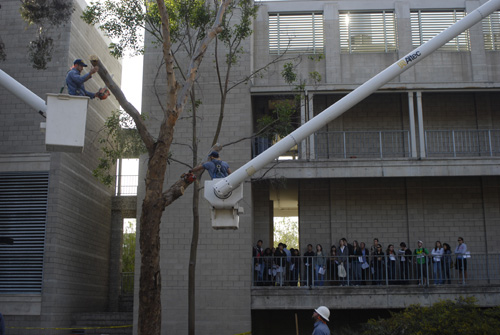Campus Urban Forest Becomes Living Laboratory
Environmental Science Students Team with Campus Forester to Better Understand Role of Trees in Global Climate Change
Ioana Patringenaru | February 8, 2010
It’s not every day that UC San Diego students have class outside, with the sound of chainsaws buzzing in the background. But that’s exactly what about 40 undergraduates did on a recent Friday morning.
Armed with measuring tape and a bathroom scale, they measured and weighed a tree that UCSD crews were cutting down because it had become unstable. The goal was to calculate how much carbon the tree held. The exercise was part of John Niles’ environmental science class, titled “Global Carbon Science Politics: The Road from Copenhagen.” It’s also an example of the hands-on approach that the campus has been adopting in many classes.
Understanding how much carbon a tree holds is important because deforestation accounts for about 15 percent of greenhouse gas emissions that cause global warming. “It’s a big part of the problem,” Niles said. Once a tree is cut, it will ultimately emit the carbon it holds, he explained.
The exercise also allowed UCSD’s Facilities Management department to make students more aware of the environmental benefits trees bring to the campus, said Sam Oludunfe, UCSD’s urban forester. “It fits very nicely with UCSD’s mission of teaching, research and public service,” he said.

Students Dana Roth and Daniel Radthorne examine a piece of the tree that Facilities Management workers cut down.
Every year, the department partners with students to plant trees. But this is the first time staff members worked hand-in-hand with students and faculty to stage an experiment in the field for a class, Oludunfe said.
Niles explained that his course is designed to give students a solid understanding of environmental science and policy. They answer questions such as: What are the main greenhouse gases? How much of them are there out there? Students also learn about climate change policy at the international, national and state level. They discuss some of the major treaties governing global warming policy, including the recent Copenhagen accord. They read primary sources detailing climate change science, including reports by the Intergovernmental Panel on Climate Change. They examine federal and state legislation.
That Friday’s exercise was designed to bring the science home through a hands-on exercise. At first, students huddled on a balcony while four Facilities Management workers hovered above in cranes, wielding saws and cutting down a sugar gum tree piece by piece.
Finally, Niles and two undergraduates were allowed near the trunk. Niles draped measuring tape around the tree, a little more than four feet, or more precisely 1.3 meters, off the ground. He emphasized the need for rigorous measurements. Place the tape too high or too low, or too loosely, and you will end up with data that is way off the mark, he said. “A small difference in diameter makes a big difference in carbon,” he warned.

Niles explains that the weight of a tree changes based on how much water it holds.
The sugar gum tree measured in at about 51.2 centimeters in diameter, or about 20 inches. Next, Niles punched in the number in a spreadsheet on his laptop and figured out the tree held 2.6 tons of biomass, meaning that it held about 1.3 tons of carbon. He was able to make the calculation because enough scientists have worked on enough sugar gum trees to come up with an equation that correlates the tree’s diameter with the amount of carbon it holds.
Equations specific to each species are only one part of the picture. Scientists also have developed equations for whole regions, taking into account many different kinds of trees. That especially comes in handy when you’re trying to gather data out in a rainforest, Niles said. There you have to measure hundreds of trees, and sometimes, you don’t even know what some of the species are. So, you have to rely on these regional equations, he explained. To make sure you get a tree’s diameter right, you also sometimes have to wield a machete and clear all the vines that cling to its trunk, he added.
He knows what he is talking about. In addition to working as a lecturer at UCSD, he runs a nonprofit organization, The Tropical Forest Group. The group helps developing countries measure carbon and supports humanitarian efforts in African nations, including Ethiopia, Uganda and Nigeria. “It’s very rewarding work,” he said.
Back at UCSD, trees on campus play a big part in helping the university fight global warming, according to a study conducted last year. The total effect of the campus’ 200,000 trees was a reduction of nearly 10,000 tons of carbon dioxide emissions per year, or 5 percent of its annual emissions. The total annual savings attributed to the trees were $2.2 million. The trees also help reduce energy use by 12,886 megawatt-hours by consuming solar energy through the process of “evapo-transpiration” and by blocking winter winds, according to the study.
After Niles wrapped up his class by handing out small sections of the tree for students to take home, several said they really enjoyed the experience. “You don’t get to go a field trip to see a tree cut down very often,” said Daniel Radthorne, a third-year student.
Aline Goganian, a third-year environmental policy major, is just back from studying for a quarter in the Barbados and took Niles’ class to learn more about the tropics and their rainforest. “He explained all this in class, but it’s cool to actually see it and do the math with real numbers,” she said.

Facilities Management workers cut down a sugar gum tree on a recent Friday morning.

|